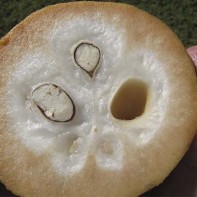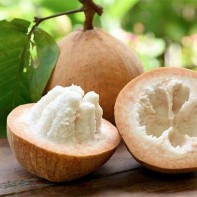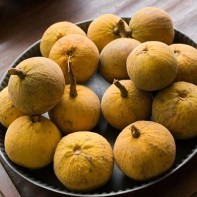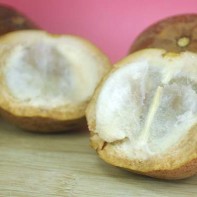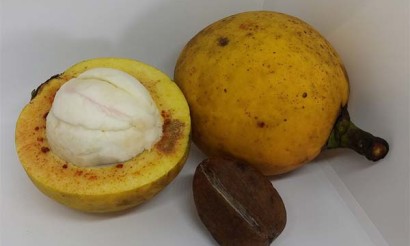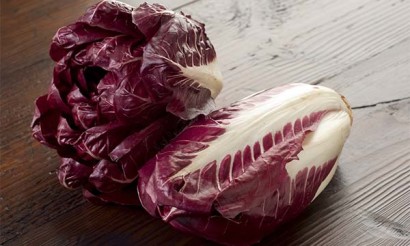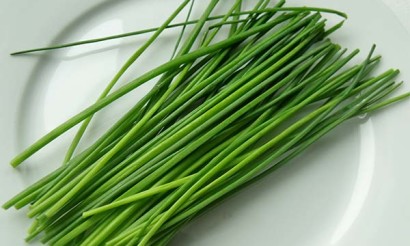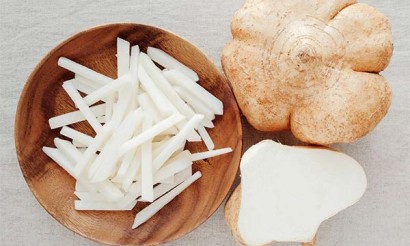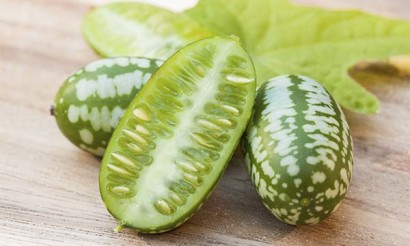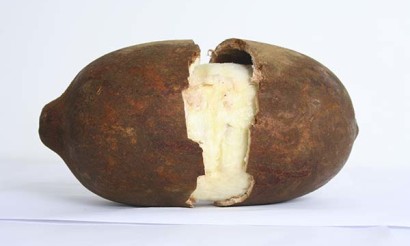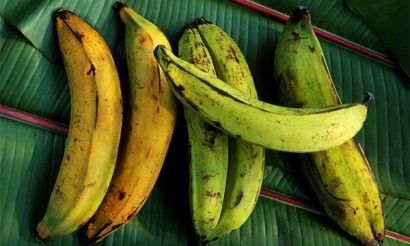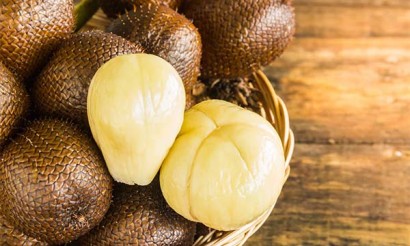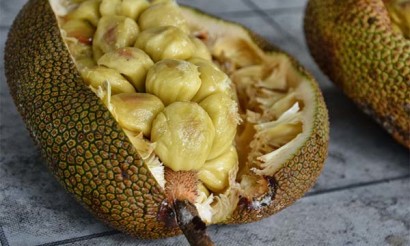Santol: what is this fruit and why is it useful?
Exotic Southeast Roots plant first cultivated in Asia. The fruit is popular for its nutritional properties and unique taste. In Russia it is rarely delivered. To bring the fruit in one piece and preserve its marketable appearance, it is harvested while still green, unfit for food. The middle belt of Russia prefers to visit its native places to enjoy the unique taste.
What is the Fruit
A member of the Meliaceae family, santol grows year-round and produces a rich harvest. It is widely known in many countries, and everywhere has its name:
- graton (Thailand);
- wild mangosteen (England);
- donka (Sri Lanka);
- compam rich (Cambodia);;
- tong (Laos).
What it looks like
An evergreen, fast-growing tree growing up to 30-45 m. Its leaves are quite large (25-30 cm long and a few cm wide). The leaves are sickle-shaped (oblong), with small inflorescences of yellow-green or pink flowers (each flower not exceeding 1 cm).
The ripe Graton has a brown or reddish hue with pigment spots. It can grow to the size of an orange or pomelo (30 cm in diameter). Its dense crust and bipedal shape with inedible seeds resemble the Wild Mangosteen (for which it is called the "false mangosteen" in France). The creamy flesh is viscous, dense in texture and has a distinct sourness. The white core is sweeter, tightly adhering to large seeds with sharp edges that are difficult to separate.
Where it grows
Graton began its distribution in Southeast Asia (Vietnam, Cambodia, the Malay Peninsula and Laos). Indonesia, India and the Philippines grew so fond of the tropical product that they began growing it on their soil.
The yellow fruit variety is found exclusively in the forests of Malaysia.
What is the usefulness of the santol fruit
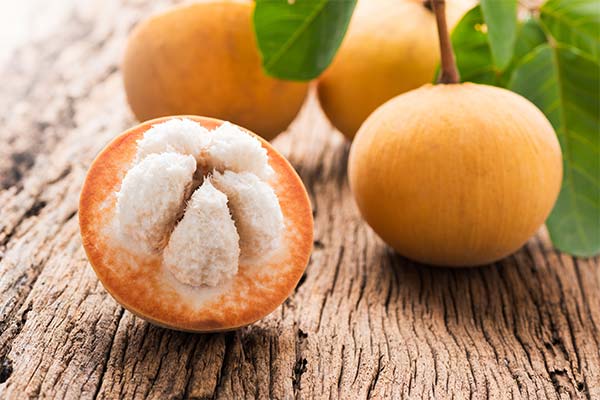
The santol has a high content of such elements:
- B1, B3 and C vitamins;
- Minerals - calcium, phosphorus, iron, phosphate;
- pectin;
- dietary fiber;
- ash;
- carbohydrates;
- acids - ascorbic, nicotinic.
Eating mangosteen regularly can improve your health, energy and appearance.
- The fruit fights cardiovascular diseases, strengthens the general immune system and bone system, stimulates blood flow, reduces the strain on the heart, dilates blood vessels and stabilizes blood pressure.
- Dietary fiber affects digestion, and pectin gets rid of toxins and removes unwanted substances.
- Vitamin C prevents colds and infectious diseases. Calcium levels (4.3 mg), strengthens the oral cavity. Teeth become less susceptible to cold or hot. Phosphorus improves visual acuity and prevents conjunctivitis.
- Vitamin complex strengthens the hair, gives hair a natural shine and accelerates its growth. Improves the structure of the nails.
What harm can come from it
People with an individual intolerance to the components should refuse the product. The elements in the composition can cause an allergic reaction: redness, intense itching, burning.
It is not recommended to eat unripe fruit. In addition to food indigestion, santol glues the lips. It is difficult to get rid of the problem on your own.
How to eat santol properly
It is advisable to eat the fruit raw. The nutrients and vitamins are lost in heat processing. There are several ways to eat the fruit:
- Cut off the layer of peel and chew it (for convenience leave a sprig).
- Cut in half, eat the sweet and sour part separately.
- Remove the skin, take out the pit, dip it in salt. Santol will become like a vegetable (tastes like natural lard).
It is very important to eat with caution. The pips can be harmful to the stomach, so they are separated from the core or sucked on. They can be kept for cosmetic use.
What you can make with santol
Graton is used in salads, juices, jams, and jams, fully ripe. Unripe or overripe fruits are used to make wine and strong alcoholic tinctures. Because of the lack of sugar in desserts do not add it, but it will be an excellent decoration of any confectionery. In Thailand and Asia they make jellies and marmalade on its basis.
Its low calorie allows you to include it in a diet diet where it will play an important role - to enhance weight loss and relieve swelling on the face and hands in the morning.
Use in folk medicine
- To treat some diseases and relieve small inflammations, swellings, use a tree of the family Meliaceae. Its leaves and bark are used to make lotions and poultices (a bandage that is applied to the affected area). Unlike an ordinary bandage, it soothes inflammation and relieves pain. Wounds and boils heal in 3-4 days.
- Clinical studies have confirmed the presence of trace elements in the stems that can detect and soothe cancerous growths, but not get rid of the problem completely. Extracts are safe for humans and do not cause side symptoms. The seeds of the plant are contraindicated for consumption, but their insecticidal properties are the best disinfectants (work with them requires caution).
- Diabetics are recommended the fruit for preventive purposes because of its low glycemic index. Controlling blood sugar levels lowers the acute need for sweets. Fiber fights harmful cholesterol and the formation of blood clots. Digestion comes back to normal, falls excess weight.
Cosmetic applications
Wild mangosteen has great popularity as a major supplement for beauty products. It is used as:
- Decoction. Antiseptic, anti-inflammatory properties relieve irritation and redness on the face, soften pores and effectively moisturize the face, penetrating deep under the skin.
- Creams, gels, masks. The astringent properties of the product tighten pores, smoothing scars after acne and black dots. It is effective against fine lines and wrinkles (mimic or age). The concentrate tones the skin, gives elasticity and forms a transparent film which prevents greasy shine, clogged pores and external impurities.
- Lotions, scrubs and emulsions. Tonga juice softens problematic, dry skin and cleanses hormonal rashes on the face. Before the procedure, the face is first steamed and cleansed from greasy shine.
- Shampoos, conditioners, oils. Vitamin complex of the fruit will enhance the recovery process of damaged and brittle hair. Products are possible to make at home.
How to grow santol

Amateur gardeners plant Tonga by seed. You can find them in online stores or bring the seeds from the fruit with you. The fruit is not very fastidious, but it does not tolerate zero temperature.
The ideal environment for the development are humus and river sand. The plant needs light soil, so it is better to use fertilizer from mature leaf compost. A small amount of decomposed manure can be added.
In the initial stages, the tree can be grown in room conditions. In a large pot, pour a mixture of humus and sand, make a shallow hole and place a seed. The earth is moistened a little, covered with a film (having previously made ventilation). The temperature in the room should be at least 28-30 ° C. When sprouting (about 2-4 weeks), the plant should be transplanted to the ground as soon as it reaches 1-1.5 meters, because the tree grows very fast. The optimum humidity is 75-80% at a constant temperature. Therefore, this tree should be grown in a greenhouse or greenhouse with a regulated heating system. At temperatures below 20°C it ceases to grow. It does not tolerate wind and draughts. A heat-loving plant does not like direct sunlight and grows well in diffused light.
Free-loving plants should be planted at a distance of 2 meters from each other. During growth, it is important to prop up the trunk on several sides, so that it does not sag under the weight of branches and future fruits.
Treatments
Proper and timely care will ensure a good yield. To do this, it is necessary to:
- Transplanting the plant. If the tree is growing on the plot, it is enough to remove the top layer of soil and pour a new one, abundantly watering with warm water.
- Several times a month loosen the soil, fertilize with additional fertilizer until the flowers open.
- Twice a year (early spring and late fall) remove dry branches.
- Conduct regular treatments against fungal, infectious diseases and pests.
- Spray the leaves with water 2-3 times a week to keep them from drying out.
- If the top layers of soil dry up, water profusely with warm water. In room conditions, the plant should be sprayed with water and shake the leaves.
Regular bath days are mandatory. Outdoors, trees are washed by rain and dried by the wind naturally, indoor plants need help with this. Procedures are carried out by several methods:
- Wiping each leaf with a damp cloth. Wipe 2-3 times a week in winter, 4 times a month.
- Dry bathing. Pre-treatment before showering. Dust accumulated on the leaves is swept away using improvised means. After that, proceed to the wet treatment.
- Shower. The soil is sealed against moisture. Use the shower and a rag to gently wipe the leaves and stem. Allow the water to run off and return it to the room.
This will help the plant get rid of potential pests and give the plant a luster.
In the first year, the young tree should be given nutrients and equipped with beneficial micronutrients for future harvests. Aphids or spider mites can cause significant damage. They attack the leaves of the hybrid when the room climate becomes dry. To prevent the appearance of parasites, the tree is completely treated with apple cider vinegar (1 tbsp. water per 1 tbsp.).
The plant is resistant to diseases, but defeat is not excluded. If red or red spots appear on the leaves, it is worth immediately treating the plant. If there are other plants in the vicinity, the infected plant should be isolated.
Using special solutions that you make yourself or buy in a special store, check the plants for the presence of fungus or bacteria. If the leaves are increasingly covered with pigmented spots after treatment, viruses are the problem. A viral disease kills the plant when it hits it. To prevent the virus from spreading, everything is burned. The flowering and fruiting period comes in the 4th year of the plant's life in July-August. To redirect nutrients to the areas where the inflorescences develop, it is necessary to cut off excess branches, thus forming the tree.
Interesting facts
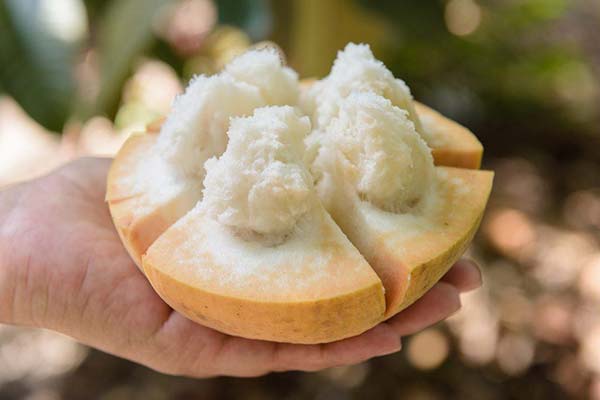
- Donk pips are not edible and can be fatal. The pulp, which is tightly attached to the seeds, hides the sharp edges, and makes it easy to swallow. In the process of digestion, the white pulp completely dissolves. The bone, on the other hand, is too hard to digest. It causes eating disorders and cuts the organs from the inside. In 20% of cases, there is no time for surgery.
- Some countries prefer to eat the fruit salted. It is similar to lard. If you add it to a salad and then salt it, the pulp opens up differently, the taste buds will perceive it as a vegetable.
- Santola wood is used to make furniture. It is easy to polish and process due to the elasticity and strength of the bark. The local population makes furniture not only for its inhabitants but also by order of tourists.
- The national dish of Southeast Asia is the catfish tam salad, which includes the fruit as the main ingredient. Thais soak the fruit like apples and pears.
- When harvested, you may notice uneven ripening. This is normal for the tropical Milia tree.
«Important: All information on this site is provided for informational purposes only for informational purposes only. Consult a professional before applying any recommendations. health care professional. Neither the editors nor the authors are liable for any possible harm caused by materials."



